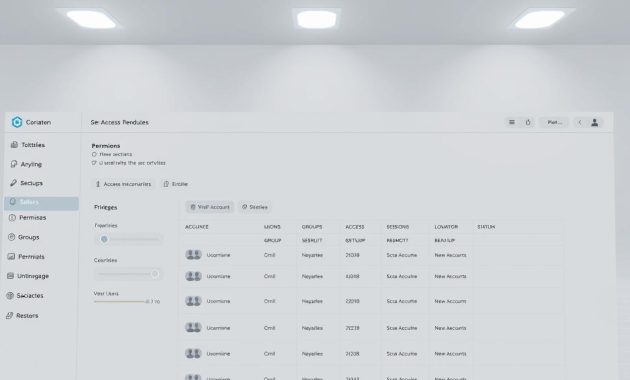In the realm of cloud server management, the implementation of a comprehensive user access management strategy is paramount. This is not merely a precautionary measure but a necessity to safeguard your cloud-based assets. The task of managing user access on cloud servers is pivotal for enhancing security, diminishing risk, and adhering to regulatory standards. By adopting a stringent approach to user access management, you can fortify the defenses of your cloud-based resources against unauthorized intrusions.
Implementing an effective user access management strategy necessitates a multifaceted methodology. This involves a thorough risk assessment, the allocation of roles, and the continuous monitoring of user activities. By adopting a proactive stance in managing user access, you can significantly reduce the likelihood of security breaches. Consequently, your cloud-based assets will be safeguarded against potential threats. In the context of cloud security, the proper management of user access is not merely advisable but indispensable for the protection of your enterprise.
Understanding the Importance of User Access Management
In the realm of cloud computing, the imperative of managing access to cloud servers becomes evident. User access management emerges as a cornerstone in safeguarding data integrity and security. It ensures that only those with legitimate authorization can access cloud-based resources, thereby mitigating the likelihood of security breaches. This necessitates the implementation of stringent controls and continuous monitoring to thwart unauthorized access and data breaches.
The establishment of a robust user access management framework is paramount for cloud server access management. Such a framework must be capable of dynamically assigning access levels based on user roles and responsibilities. This approach guarantees the protection of sensitive data and resources from illicit access.
- Authentication and authorization
- Role-based access control
- Least privilege principle
Adopting these strategies enables the effective governance of cloud server access, thereby safeguarding data against potential security threats. It is imperative to recognize that user access management is a continuous endeavor, necessitating perpetual vigilance and updates to maintain the security and integrity of cloud-based assets.
Key Principles of User Access Management
Implementing cloud server access management necessitates a grasp of fundamental principles that underpin user access management principles. These principles are crafted to ensure that users are granted only the permissions requisite for their duties, thereby curtailing the risk of illicit access. By adhering to these principles, you safeguard your cloud-based assets and uphold the sanctity of your data.
Managing user access entails consideration of several pivotal principles. These include:
- Granting users the least amount of privilege necessary to perform their tasks
- Assigning roles to users based on their job functions and responsibilities
- Regularly reviewing and updating user access permissions to ensure they remain relevant and necessary
Adherence to these principles fortifies your cloud server access management strategy, thereby ensuring the security and integrity of your cloud-based resources. This, in turn, guarantees that users possess the requisite access to execute their duties with efficiency.
Adopting user access management principles is imperative for any entity leveraging cloud-based services. Such implementation minimizes the likelihood of data breaches and other security threats, while ensuring users have the necessary access to fulfill their duties. A robust cloud server access management strategy is indispensable for safeguarding the security and integrity of your cloud-based assets.
Tools and Technologies for Managing User Access
In your quest to fortify user access management on cloud servers, you encounter a plethora of tools and technologies. Effective management of user access is paramount in safeguarding your cloud-based assets. The selection of the most appropriate user access management tools for your entity is imperative.
Identity and access management (IAM) solutions stand out as a cornerstone, offering a unified platform for overseeing user identities and access to cloud resources. Additionally, multi-factor authentication (MFA) introduces an additional security dimension to the authentication process.
Access management software and security information and event management (SIEM) systems also play critical roles. These tools facilitate the monitoring and analysis of user activity, the detection of potential security threats, and swift incident response. By integrating these tools and technologies, you can enhance your user access management strategy and fortify your cloud-based assets.
The utilization of these tools and technologies for managing user access on cloud servers yields several advantages. These include enhanced security, augmented efficiency, and adherence to regulatory mandates. By employing user access management tools, you can guarantee that only authorized personnel access your cloud resources, with their activities meticulously monitored and documented.
Establishing Clear Access Policies
In the development of your user access management strategy, it is imperative to formulate access policies that resonate with your organization’s security objectives and adherence to regulatory mandates. This necessitates the creation of policies that delineate the principles and directives governing user access management, encompassing both user access management policies and cloud server access policies. Such an approach guarantees the efficacy and pertinence of your access policies, thereby bolstering your overall security stance.
When delineating access control policies, several critical aspects must be considered:
- Define roles and responsibilities for users and administrators
- Establish access levels and permissions for each role
- Develop procedures for requesting and approving access
- Implement measures for monitoring and auditing access
It is paramount to conduct regular policy reviews and updates to maintain the efficacy and relevance of your access policies. This entails the continuous evaluation and revision of policies to reflect alterations in your organization’s security objectives, regulatory compliance, and evolving user access management requirements. By establishing unequivocal access policies and engaging in periodic reviews and updates, you can ensure that your user access management strategy is in harmony with your organization’s overarching security posture. This, in turn, facilitates the effective management of user access to your cloud servers through the implementation of user access management policies and cloud server access policies.

Monitoring and Auditing User Access
In the realm of user access management, the imperative of monitoring and auditing user access on cloud servers cannot be overstated. This diligence is pivotal in the detection and mitigation of security breaches in real-time, thereby safeguarding the integrity of your cloud infrastructure. User access monitoring emerges as a cornerstone in the identification of potential security threats, facilitating proactive countermeasures.
The implementation of cloud server access auditing enables the tracking of user activity, the identification of areas for enhancement, and the refinement of your user access management strategy. Through the analysis of audit logs and reports, you can derive insights into user behavior and system performance. Such data is instrumental in the optimization of access control policies, ensuring their congruence with your organization’s security objectives.
- Real-time threat detection and response
- Improved incident management and remediation
- Enhanced compliance with regulatory requirements
- Optimized user access management strategies
By prioritizing user access monitoring and cloud server access auditing, you can fortify your cloud security posture and safeguard your organization’s sensitive data. The regular practice of monitoring and auditing positions you to stay one step ahead of potential security threats, thereby ensuring the confidentiality, integrity, and availability of your cloud-based assets.
Responding to Security Incidents
In the realm of cloud server management, the anticipation of security breaches is paramount. A meticulously crafted user access incident response strategy is crucial for mitigating the repercussions of such incidents and averting future threats. Upon the occurrence of a security breach, the imperative is to execute a swift and precise response, aimed at limiting the extent of the damage.
A robust cloud server security incident response framework necessitates adherence to several pivotal phases. These phases are delineated as follows:
- Identify the incident and assess its severity
- Contain the incident to prevent further damage
- Eradicate the root cause of the incident
- Recover from the incident and restore normal operations
- Conduct post-incident activities to identify areas for improvement
Adherence to these phases, coupled with a meticulously planned incident response strategy, ensures that your organization is adept at addressing security incidents related to user access on cloud servers. This proactive stance safeguards your sensitive data and fortifies the trust of your users.

Training and Awareness for Users
To ensure the effective management of user access on your cloud servers, investing in user education and continuous learning is crucial. By providing your users with the necessary user access training and resources, you can empower them to become active participants in maintaining the security of your cloud infrastructure.
Fostering a culture of cloud server security awareness within your organization is key. Regular training sessions, informative webinars, and easy-to-access online courses can equip your users with the knowledge and skills to navigate the complexities of user access management. These educational initiatives will not only enhance their understanding of best practices but also instill a shared sense of responsibility for safeguarding your cloud environment.
Encourage your users to explore industry-leading resources, such as security certifications, security awareness programs, and expert-led workshops. By staying informed and up-to-date, your users will be better equipped to identify and respond to potential security threats, contributing to the overall resilience of your cloud infrastructure.
